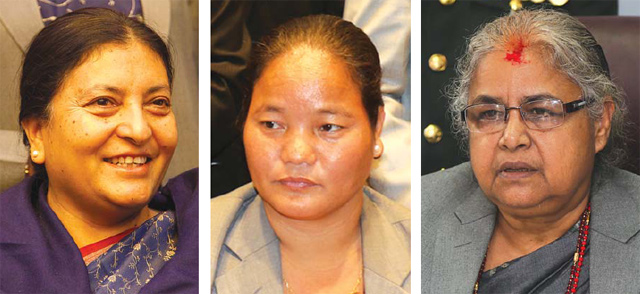Constitution hasn’t ensured 33 percent representation of women in all state organs
Bhrikuti Rai / September 15, 2016

(From left) President Vidya Bhandari, Speaker Onsari Gharti and Chief Justice Sushila Karki. Photo courtesy: Nepali Times
In an opinion article titled “The pitiable 33 percent!” by former minister Kalpana Dhamala published in Kantipur (September 9, 2016), Dhamala has stated that Nepal’s constitution provisions that 33 percent women’s representation should be ensured in all state bodies.
Also, many people believe this to be true.
We checked whether Dhamala’s statement is correct.
Regarding women’s rights, Article 38 (4) of the constitutions states: “Women shall have the right to participate in all bodies of the state on the basis of the principle of proportional inclusion.”
Similarly Article 50 (1) relating to the directive principles of the state says, “…principle of proportional participation in the system of governance…” will be embraced.
Similarly, Article 84 (8) has a provision regarding 33 percent women’s representation in the federal parliament. It states, “Notwithstanding anything contained elsewhere in this Part, at least one third of the total number of members elected from each political party representing in the Federal Parliament must be women. If women are not so elected as to constitute one third of the elected members of any political party under sub-clause (a) of clause (1) and sub-clause (a) of clause (2) of Article 86, such political party must, in electing members under sub-clause (b) of clause (1), so elect that women members constitute at least one third of the total number of members elected to the Federal Parliament from that party.”
Although the constitution states proportional representation for women in all states structures it is silent about 33 percent women’s representation when it comes to specific institutions including the army and the judiciary. Barring the central parliament, the upper house and state parliaments and local governments, there is no provision to ensure participation of 33 percent women.
For instance, the provision regarding Nepal Army in the constitution states, “The entry of women, Dalit, indigenous communities, Khas Arya, Madhesi, Tharu, Muslim, people from backward class and backward region shall be ensured in the Nepal Army, based on the principle of equality and principles of inclusion as provided for in the federal law.” Here too the vague use of language makes its unclear how women’s participation will be ensured under the “principles of inclusion”. Similarly, the constitution is silent about women’s representation in the Nepal Police and the Armed Police Force.
The constitution says that the position of president and vice president will be held by people from different sexes or communities but this does not ensure that presidency or vice presidency will be provided to women at all times.
Most importantly, new laws need to be formulated to implement all the aforementioned provisions. Therefore, while the constitution states that it will embrace “principle of proportional inclusion” for women’s representation, there are no clear provisions to ensure 33 percent representation of women in all state bodies.
This material is copyrighted but may be used for any purpose by giving due credit to southasiacheck.org.
Comments
Latest Stories
- In Public Interest Covid-19 cases are low, but that’s not an excuse to avoid vaccination
- In Public Interest What is BF.7, the sub-variant that has the world by its grip?
- In Public Interest Threat of a new Covid-19 wave looms large amid vaccine shortage in Nepal
- In Public Interest As cases decline, Covid-19 test centres in Kathmandu are desolate lot
- In Public Interest Dengue test fee disparity has patients wondering if they’re being cheated
- In Public Interest As dengue rages on, confusion galore about what it is and what its symptoms are. Here’s what you need to know
In Public Interest
 Covid-19 cases are low, but that’s not an excuse to avoid vaccination
The Pfizer-BioNTech bivalent vaccines authorised by the Nepal Government provide better protection a...
Read More
Covid-19 cases are low, but that’s not an excuse to avoid vaccination
The Pfizer-BioNTech bivalent vaccines authorised by the Nepal Government provide better protection a...
Read More
- What is BF.7, the sub-variant that has the world by its grip?
- Threat of a new Covid-19 wave looms large amid vaccine shortage in Nepal
- As cases decline, Covid-19 test centres in Kathmandu are desolate lot
- Dengue test fee disparity has patients wondering if they’re being cheated
- As dengue rages on, confusion galore about what it is and what its symptoms are. Here’s what you need to know